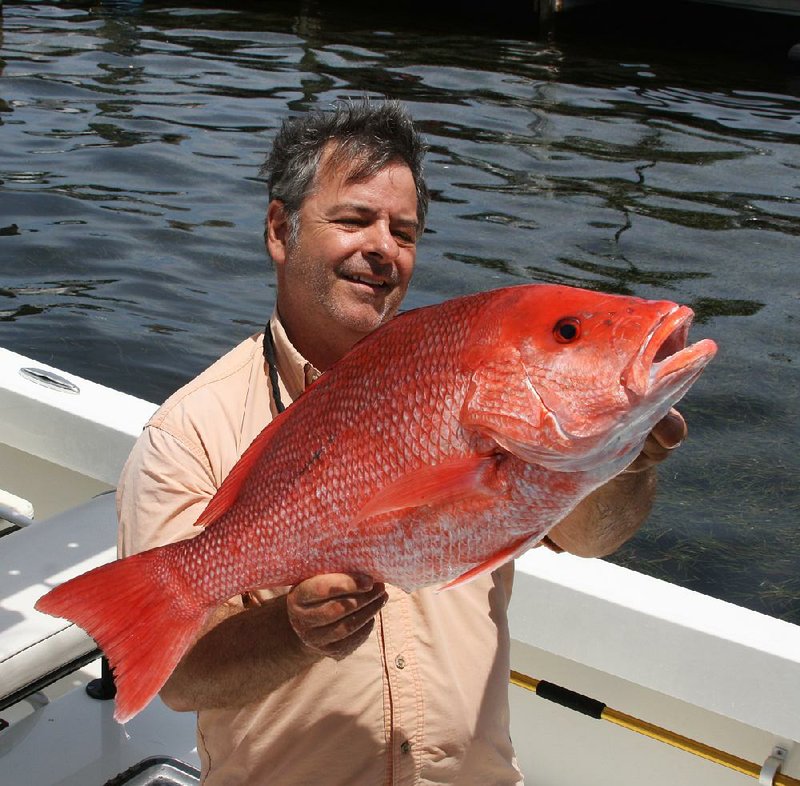PANAMA CITY, Fla. -- Arkansas anglers love to sight fish for largemouth bass, so imagine how exciting it is to sight fish for double-digit size red snappers.
That was just one of many adventures I experienced May 12-15 while filming an episode of Chasin' The Sun, a television program devoted to fishing at Panama City. In its premier season, the show is the brainchild of Jamie Wilkinson, the Bassmaster Classic's logistical manager during the Classic's time with ESPN. Our episode will air in 2017 on NBC Sports.
My guide was Capt. Justin Leake, head of panamacityinshore.com. He specializes in catching big fish on fly and light tackle.
Our fishing the first day was delayed for about 30 minutes when we encountered two whitetailed deer swimming out to sea. Beachcombers had spooked them into the water, and they were in distress when we encountered them about a half mile offshore. Leake and his compatriot Todd Jones, who was in another boat with a cameraman, turned the deer and herded them back to the beach.
Shortly after, Leake marked a school of amberjacks on his Garmin graph. We taunted them with Yo-Zuri Surface Cruisers, a big pencil-type popper. We used Shimano Teramar rods and Shimano Saragosa spinning reels with 65-pound braided backing and 30-pound test flourocarbon leaders.
Leake also replaced the treble hooks on the poppers with single hooks.
"It's easier on the fish, and it's easier on me," Leake said as he subdued a brawling amberjack. "The fewer hooks you have to deal with, the better."
On every cast, as many as a dozen amberjacks fought over the popper. The faster and more frantic the retrieve, the more violent the chase.
The jacks were all about 34 inches long, and they were uncommonly strong. I buried the rod butt in my side, struggled to keep the tip level with the water and tried to reel in more line than they stripped.
Leake demonstrated a technique that's similar to "doodlesocking" for largemouth bass. With only 2-3 feet of line, he slapped the popper on the water next to the boat and whizzed it back and forth in a figure 8.
When a big fish hits so close to the boat on so little line, the fish stands a good chance of taking your rod away.
We also caught bonita and another racecar jack species called blue runners.
By midmorning on the second day, I was about spent, but the fun was just beginning.
It was opening day of red snapper season in Florida, and Leake took us to a couple of obscure structures several miles offshore.
He put out a bag full of frozen chum to leach into the water, then he threw out big chunks of cut bait.
The emerald water was so clear that we could see at least 40 feet down. Red snappers flashed in the sunlit depths as they rose to eat the chunks. Leake attached a chunk of cut bait to a circle hook, but the snappers wouldn't take it.
"That 30-pound leader is too heavy," Leake said. "It's making it fall too slow in this current, and it doesn't look right to the fish."
He replaced the 30-pound leaders with 20-pounders, and those baits drifted at the same rate as the free-falling bait.
Through bronze-colored shades, it was easy to watch. A big red snapper sucked down a trio of free-falling chunks, and then it nosed up to my bait.
"He's thinking about it!" Leake said. "Get ready!"
In a flash, the snapper inhaled the bait.
"Just close the bail and start reeling," Leake said. "That circle hook will get him."
I reeled in the slack line, and then it felt like I'd hitched a ride on a comet. The rod bent to the water, and my flank protested as I buried the rod in my side. This fish was definitely more substantial than those 34-inch amberjacks.
It weighed about 18 pounds, and I caught another that weighed about 14 pounds to complete my two-fish limit. Cheryl Little, our camera operator, also caught a pair. You can see her video at arkansasonline.com.
Leake cut up the rest of his bait and threw it to the fish.
"They've been very good to us this morning, so they deserve a reward," Leake said.
On the way back to the dock, Leake stopped near the jetties at St. Andrews State Park, on the east end of Panama City Beach.
"There's a big school of redfish that hang out here, and there's just enough tide left that we might get one to bite," Leake said.
He rigged a bait on a modified drop shot rig and told me to let it go to the bottom.
We drifted through the school twice, and a big red finally accepted the challenge.
"There's no telling how many fish looked at that bait until one said, 'If you guys ain't gonna eat that, then I guess I will!"
I caught my first saltwater fish at Panama City in 1974, including a mess of red snappers. They were a lot smaller than these snappers, but our captain was very happy with them.
"It's so much better now," Leake said.
My sore arms and bruised side agree.
Sports on 05/29/2016
